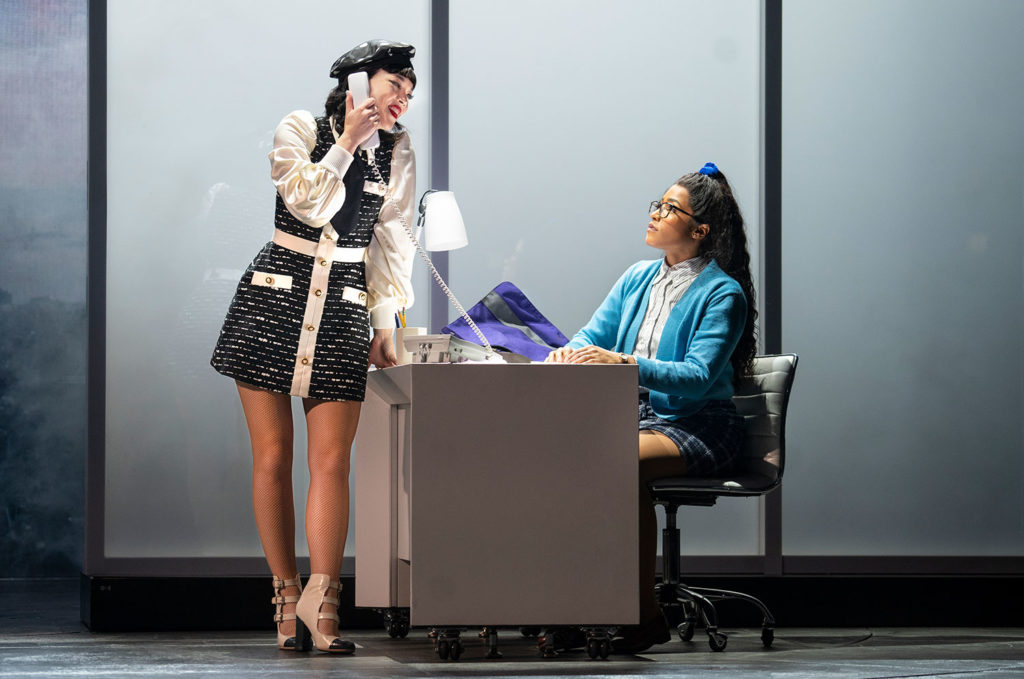Last week, the producers of The Devil Wears Prada scored some publicity off of a visit from the show’s composer. “Elton John Attends Performance in Chicago!” read a press release after John saw a preview performance of the new musical Wednesday night; following the curtain call, we were told, “he went backstage to share a special moment with the cast.”
It was nice timing, perhaps, that John’s visit to Chicago for Friday night’s Soldier Field concert — apparently his last appearance here, as he winds down his extended farewell tour this fall — coincided with his side project.
But was it really something to celebrate that Prada’s score writer, the marquee talent behind this Broadway-aimed new musical, first saw the show from the audience? Was it such a feel-good moment that, in a process as necessarily collaborative and iterative as the creation of a theater production, the composer seemingly met the actors for the first time weeks into the show’s initial run?
That knowledge sat at the back of my mind as Prada opened to the press Sunday night. Based on Lauren Weisberger’s 2003 novel and the 2006 film adaptation that starred Meryl Streep and Anne Hathaway, Prada follows an ambitious young writer as she takes a job as an assistant to the legendarily demanding editor-in-chief of a glossy fashion magazine.
Weisberger wrote her book after a stint working for Vogue editor Anna Wintour; Prada’s devil, Miranda Priestly, is the top boss at Runway magazine, where the decidedly non-fashion-minded Andy Sachs improbably lands the job that “a million girls would kill for.” Told that a year meeting Miranda’s high expectations will open plenty of doors in New York City publishing, Andy determines to tough it out — and soon finds herself warming to the glamorous life, while her friends start to feel left behind.
But as Kate Wetherhead’s script ticks off the familiar beats from Weisberger’s book and, particularly, the much-loved film — some of the biggest cheers on opening night were for lines borrowed from Aline Brosh McKenna’s screenplay — it’s so far lacking in something that’s vital to fashion, magazines, and theater: an editorial outlook.
Andy’s primary mode here is ambivalence, from beginning to end, and while rising star Taylor Iman Jones definitely shines, vacillation is a tough note to play. Miranda, portrayed onscreen by Streep as a supremely detached ice queen, is played here by Beth Leavel as less imperiously unapproachable and more mildly annoyed. Miranda needs to be seriously intimidating, but Leavel, a well-loved Broadway trouper, might just be too naturally warm to give us chills.

Wetherhead makes decided improvements to some side characters. Andy’s boyfriend Nate, played by Adrien Grenier in the film as a needy, resentful mope, is given better motivations and comes across as far more empathetic as played here by Michael Tacconi. And the delightful Javier Muñoz as creative director Nigel (the Stanley Tucci role in the movie) gets both a mildly beefed-up backstory and better songs than either Andy or Miranda.
But then, none of John’s score here is truly grabby at this point; the composer doesn’t seem to have given much thought to character motifs or coherent themes. Shaina Taub’s lyrics have flashes of wit, but frequently repeat themselves to fill John’s melodies. With the reminder last week that John hasn’t been in the room, it’s hard not to think of the score as phoned in.
And there’s one missed opportunity that glares. Thanks to the casting of Jones, Muñoz, and Megan Masako Haley (underutilized as Andy’s rival assistant), the main targets of Miranda’s abuse have all become characters of color. Given the systematically shoddy way nonwhite workers have been treated in the fashion industry and at the real-life Condé Nast, you might think something would be made of race, but the show doesn’t go there.
The Devil Wears Prada isn’t a finished look; the current run at the James M. Nederlander Theatre is what used to be called an “out-of-town tryout,” where the creative team can get the show in front of audiences and see what works and what needs to be fixed. Director Anna D. Shapiro, the former Steppenwolf artistic director, gets to do that work on her home turf. Even though many major critics descended on Chicago to review the work in progress, there’s still time to refashion this material so it’s runway-ready.
The Devil Wears Prada continues through August 21 at the James M. Nederlander Theater. For ticket information, go to broadwayinchicago.com.




